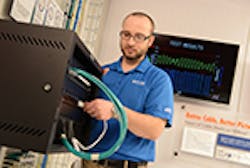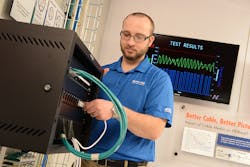A/V & HDBaseT: Best Practices for Maximizing Performance with High Bandwidth Convergence
Audio/Video Technology Evolution
The advances in A/V technology over recent history have been nothing short of amazing. Up until about the year 2000, standard definition television technology called NTSC (National Television System Committee) was in virtually every household in America. Televisions had a resolution of 480i and used an aspect ratio of 4:3. Similar resolutions and aspect ratios were used with both desktop and laptop computers.
Fast forward to 2016, and HD Televisions (HDTV) fill the department store shelves and are extremely popular in American households. HD televisions typically have resolutions of 1080p, and display a picture in an aspect ratio of 16:9, making the screen 78% wider than high. Additionally, 4K technology is quickly making its way to the mainstream as well. 4K technology is often called UHD, or Ultra High Definition, and it offers resolutions that are more than double what high definition technology can offer. On the horizon, Japan is planning to broadcast the 2020 Tokyo Olympic Games using 8K technology!
Couple all of this with the fact that the above-mentioned technology advances are also incorporated into IP devices in both the consumer and enterprise environments. For example, the iPhone 6S, released in September 2015, has the capability to take 4K resolution video. Most modern IP devices have at least HD quality resolution, and many devices use 16:9 aspect ratio.
HDBaseT Technology
HDBaseT is a technology developed to distribute multimedia content with ultra high definition over twisted pair structured cabling. The HDBaseT 1.0 specification was finalized in June 2010, and the HDBaseT 2.0 specification, adding even more advanced capabilities, was released in 2013. The HDBaseT Alliance touts something they call 5Play™. This means that HDBaseT technology can simultaneously transmit the following five things over a single four-pair cable:
- Uncompressed Video (up to 4K)
- High Definition Audio
- 100BaseT Ethernet
- Power (up to 100W) (POH)
- Various Control Signals
It is important to note that even though HDBaseT is designed to operate over Category cabling to a maximum length of 100 meters, it does not use an Ethernet protocol. Therefore, active Ethernet equipment will not transmit the proprietary HDBaseT protocol, even though the structured cabling infrastructure will support it.
The technology behind what makes these high resolutions possible is extremely complex. Full HD requires less than 5Gbps (Gigabits per second), but 4K requires about 10Gbps, and when 8K is available, the bandwidth required will be approximately 20Gbps. New AV technologies that incorporate structured copper cabling (HDBaseT for example) deliver 4K video content uncompressed in order to minimize latency. HDBaseT incorporates several advanced technologies that allow it to transmit 4K video along with everything else in 5Play. HDBaseT uses an innovative Digital Signal Processing (DSP) engine and it employs a PAM16 encoding scheme to enable 4K ultra high resolution. Taken together, the advanced DSP and the PAM16 encoding scheme allow for a robust platform for distributing 4K video.
Converged Application Testing
The TEK Center at Berk-Tek conducted testing to determine how well different structured cabling infrastructures supported HDBaseT in various conditions. The TEK Center engineers prepared 6-around-1 bundles of various Category 6A and Category 6 cables, then configured them into 100-meter, four-connector channels.
Every cable of every bundle was first Fluke-tested to ensure each met the Category 6 or Category 6A performance accordingly. After successful performance testing, the TEK Center began HDBaseT testing by energizing only the victim cable while transmitting HDBaseT in either 1080p or 4K UHD. Then, the test was repeated, but the six disturbers were also energized with 10GBASE-T traffic (similar frequency to HDBaseT) to find what happens when alien crosstalk develops within the 6-around-1 cable bundle.
Then, the TEK Center turned up the heat! In environments like hot plenum spaces (think Arizona summertime), combined with up to 100W of PoE, the cables toward the center of the bundle especially will get hot. Heat creates higher attenuation that will negatively impact performance. The TEK Center tested all bundles configuration at 75˚C (167˚F) or 90˚C (194˚C), depending on the cables’ temperature listings.
Click here to download the full Test Results
Test Results & Structured Cabling Recommendation
An important point to note is that the HDBaseT website will recommend Category 6 cabling. While it is possible that Category 6 will work for HDBaseT, the probability for success decreases significantly (as demonstrated by the TEK Center’s testing) with any of the following:
· When multiple cables are bundled and transmitting HDBaseT, especially 4K UHD.
· The closer to the maximum length of 100 meters
· Any electromagnetic noise sources close to the structured cabling (fluorescent light ballasts, power cables, etc)
· Operating environments where elevated temperatures occur
When transmitting high definition, ultra high definition or beyond, alien crosstalk (cable-to-cable noise) starts to become a significant factor. The structured cabling system has to be designed to account for alien crosstalk, especially when cables are bundled, and unfortunately Category 6 products were not designed for this. Additionally, the structured cabling system will most likely also be carrying power (up to 100W) to energize the display monitor eliminating the need for a separate outlet. This will elevate the temperature (especially in a cable bundle) further stressing the network infrastructure.
For any installation where HDBaseT or any other high-definition video application will be connected, Berk-Tek recommends a Category 6A cable such as LANmarkTM-XTP. LANmark-XTP’s built-in cross-talk prevention (XTP) shielding technology allows for outstanding signal isolation, protecting your IP traffic from outside interference. The intermittent spaces in its shield are designed to prevent electrical energy (noise) from running along the shield and creating a current, so no grounding is required. Its XTP shielding technology is also designed to efficiently dissipate heat. As shown in the TEK Center’s testing, the LANmark-XTP experienced 30% less heat rise under the same PoE load as a standard Category 6A UTP product with no shielding. Finally, like all of Berk-Tek’s copper cables, LANmarkTM-XTP is manufactured with premium jacketing compounds to ensure your IP traffic is protected from the stress and strain of installation in the real world.
Click here to learn more about HDBaseT
About Berk-Tek
For more than 50 years, Berk-Tek has been a leading manufacturer of more than 100 different network copper and fiber optic cable products. The company has led in the development of high-performance and enhanced fiber optic and UTP cables designed to transport high-speed data and voice transmissions. Berk-Tek has manufacturing facilities at New Holland, PA, and Fuquay-Varina, NC. For more information, visit www.berktek.com.

